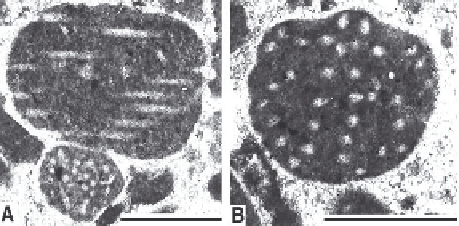Geology Reference
In-Depth Information
to mid- and high-latitudinal shelf settings. Balanid
shells form a large part of 'bryomol' and 'barnamol'
sediments (Sect. 12.2.2.1). Fossil balanids have been
known since the Cretaceous and are common constitu-
ents of Late Tertiary nontropical carbonates (Kamp et
al. 1988; Pl. 106/3).
Favreinids
A somewhat curious microfossil characterized by
small micritic bodies with numerous spar-filled eyes
has been described from Mesozoic shallow-marine
limestones as
Favreina (
Fig. 10.51), which is a micro-
coprolite. Some thalassinid decapod crabs produce fe-
cal pellets exhibiting characteristic sieve-like patterns
of tubules formed by projections from the intestine
walls. The shape, arrangement and size of the calcite-
filled tubules are used for taxonomic differentiation.
Mass accumulations of these fecal peloids, com-
monly associated with smaller peloids or ooids, con-
tributed significantly to the formation of extended
sheats of carbonate sands in the latest Jurassic and ear-
liest Cretaceous restricted lagoons (Pl. 93/5, Pl. 136/
9).
Fossil decapod coprolites assigned to
Favreina
and
similar genera have been reported from Devonian to
Tertiary limestones. Most reports deal with Jurassic
and Cretaceous favreinids, followed by Triassic find-
ings. Rock-building occurrences are abundant during
the Late Jurassic-Early Cretaceous time interval. A
bibliography prepared by J. Blau can be found on the
Internet.
Fig. 10.51.
Longitudinal (A) and cross section (B) of
Favreina
,
a microcoprolite of decapod crabs. The patterns caused by
the arrangement of the calcite-filled canals are used for taxo-
nomic differentiation. Lowermost Cretaceous (Berriasian):
Kinsau well, Bavaria, Germany. Scale is 500
m.
A. (eds.): Introduction to marine micropaleontology. -
109-149, New York (Elsevier)
Schweigert, G., Seegis, D., Fels, A., Leinfelder, R. (1997):
New internally structured microcoprolites from Germany
(Late Triassic/Early Miocene), Southern Spain (Early/
Middle Jurassic) and Portugal (Late Jurassic): Taxonomy,
palaeoecology and evolutionary implications. - Paläonto-
logische Zeitschrift,
71
, 51-69
Further reading:
K127 (ostracods),
K139
(favreinids)
10.2.4.8 Trilobites
Fragments of trilobites may be common in Early Pa-
leozoic shelf limestones. Trilobites are extinct, exclu-
sively marine arthropods restricted to the Early Cam-
brian to Late Permian time interval. Most trilobites lived
in fairly shallow water and were benthic; a few may
have been pelagic, floating in the water column. Benthic
forms walked on the sea bottom and fed on detritus.
The segmented dorsal exoskeleton is longitudinally
differentiated into an anterior head shield (cephalon),
the thorax consisting of a few to many segments, and a
tail shield (pygidium). Laterally the skeleton is subdi-
vided into a raised axial portion and two lateral por-
tions. The surface of the skeleton is smooth or vari-
ously ornamented with tubercles, spines and other ele-
ments.
Basics: Crustacean arthropods
Bourget, E. (1980): Barnacle shell growth and the relation-
ship to environmental factors. - In: Rhoads, D.C., Lutz,
R.A. (eds.): Skeletal growth of aquatic organisms. - Top-
ics in Geobiology,
1
, 469-492, New York (Plenum Press)
Dall, W., Moriarty, D.J.W. (1983): Functional aspects of nu-
trition and digestion. - In: Bliss, D.E. (ed.): The biology
of Crustacea. Volume 5. Internal anatomy and physi-
ological regulation. - 215-261, New York (Academic
Press)
Kaesler, R.I. (1987): Superclass Crustacea. - In: Boardman,
R.S., Cheetham, A.H., Rowell, A.J. (eds.): Fossil inver-
tebrates. - 241-257, Palo Alto (Blackwell)
Molinari Paganelli, V., Pichezzi, R., Tilia Zucchari, A. (1980
and 1984): I coprolithi di crostacei. Rassegna biblio-
grafica e annotazioni tassonomiche. Parte I. Genere
Favreina
. Parte II. Generi
Helicerina, Palaxius, Para-
favreina
e
Thoronetia
- Bolletino del Servizio geologico
d'Italia,
100
(1979), 409-454
and
104
(1983), 309-344
Moore, R.C., Pitrat, C.W. (eds., 1961): Arthropoda 3. Crusta-
cea Ostracoda. - Treatise on Invertebrate Paleontology,
part Q, 442 pp., Lawrence (Geological Society of
America)
Pokorny, V. (1978): Ostracodes. - In: Haq, B.U., Boersma,
Shell structure:
The skeleton consists of chitin hard-
ened by impregnation with calcium phosphate and cal-
cite. The microstructure of the finely layered shell is
homogeneous prismatic (Pl. 94/ 6). Some trilobite frag-
ments are characterized by fine pores or canals oriented
perpendicular to the surface (Pl. 94/1, 3). Trilobite
spines may be confused with brachiopod spines, but
the latter consist of two calcite layers showing concen-
tric foliated structures in contrast to homogeneous pris-
matic trilobite spines.

